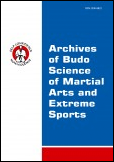2015, Volume 11, Issue 1
Change of the actions declared in simulated situations involving interpersonal aggression
Ryszard Kałużny1, Grzegorz Kalina1
1University of Lower Silesia, Wroclaw, Poland
Author for correspondence: Ryszard Kałużny; University of Lower Silesia, Wroclaw, Poland; email: ryszard_kaluzny[at]op.pl
Full text
Abstract
Background and Study Aim: One of the research tasks most difficult in methodological sense is to anticipate human actions and behaviours in the potential situations involving physical aggression. The goal of the study is to answer the question whether regardless of the aggressor's aim people are willing to take countermeasures in a comparable manner or even to refrain from an active defence.
Material and Methods: Ten years after socio-political transformation in Poland (1999) we studied 1472 persons (1123 males and 349 females), including: graduates of various types of secondary schools directly after their graduation and working in various professions (n = 454); 1st to 3rd year students (n = 435); university graduates working as a teacher, physician, official, military-, police- and prison officer, etc. (n = 583). The average age of respondents amounted to 27.3 years (19 to 58 years). Studies involved verbal simulation and KK’98 questionnaire with verified accuracy and reliability.
Results: During a hypothetical assault on bystanders, with no attack’s goal revealed, most respondents (68.41%) declared that they would respond to aggression with more aggression, whereas 29.08% of them assumed that they would take up action in line with the criteria related to the right of self-defence and 2.51% would not react. When the goal of a hypothetical aggressor was to kill the respondents, a radical change in answers could have been observed: 29.49%; 60.12%; 10.39%, responsively.
Conclusion: It seems that the awareness of aggressor’s goal and a target of physical assault are the factors which highly influence the behaviour of people who are in the social environment and in certain relationship with the aggressor. There is a clear tendency for respecting the criteria related to the right of self-defence when aggression is channelled directly towards the respondent which speaks in favour of the Old Testament principle “an eye for an eye”.
Key words: aggressiveness, bravery, right of self-defence, security science, verbal simulation





